Junk Journal Definitions & A-Z Junk Journal Glossary For Beginners
If you’re new to junk journaling and are looking for some junk journal definitions to help you out with any of the following questions:
- What does RAK mean?
- What’s an ATC card?
- What even is a junk journal?
Then you’ve come to the right place!
I had these same questions when I started junk journaling, so I wanted to create a resource (an A-Z glossary if you will) full of junk journal terms and definitions to help you out in your journey. I hope you find it useful.
And yes, I’ll update it as and when I think of more jargon and confusing acronyms to add to it. Am I missing any already? Probably. So help a girl out and comment below with what I’ve missed. Please and thank you!
Junk Journal Definitions: The Big One – What is a Junk Journal?

According to Urban Dictionary, a junk journal is “a book handmade from memorabilia/ephemera/photos out of recycled or vintage material significant or visually appealing to the intended owner.”
But that sounds a little too dry for my liking.
Here’s my definition: “A junk journal is a book that’s made (usually by hand) out of found and recycled materials, such as packaging, junk mail, paper scraps, book pages, music sheets, maps, illustrations, and ephemera (think stamps, ticket stubs, postcards, greeting cards, fussy cut pictures, etc), and is a place where one can record their thoughts, ideas, memories, and musings.”
In other words, a junk journal is whatever you want it to be and can be made out of whatever you think looks good and will be useful to you.
You might want to use a junk journal as a daily diary or somewhere to record poetry or song lyrics that mean something to you. As for me? I have a botanical junk journal that I’m using to record my findings about flowers and plants I like. Long story short, your junk journal is for you. It can be whatever you want it to be.
Junk Journal Glossary: An A-Z List To Help You Figure Out All Those Confusing Acronyms and Jargon

Once you start junk journaling and watching tutorials on YouTube, you’ll probably start to notice various words or acronyms that get thrown around.
Unsure what they mean? Take a look at the list below for definitions and examples of some of the most commonly used junk journal words and phrases.
Accordion Journal
An accordion journal or accordion book is a type of journal you can make that doesn’t require any kind of sewing or traditional book binding.
Instead of binding pages together, you simply fold or attach your papers to form a book-like structure – though you can get creative with the shape if you like! Either way, when you unfold the pages, they should form a continuous line.
You could make your accordion journal into a writing journal, or you could have pockets on every page for a fun way to store ephemera and keepsakes – as I did with this travel-themed journal.
Altered Book Journal
Altered book journals or altered book junk journals involve removing roughly two-thirds of the book pages, leaving the remaining ones intact, which you can fold and glue together to make various pockets.
This is one of the easiest ways to get started with junk journals as you don’t have to construct the journal or bind any pages.
You might want to use an altered book journal for collage spreads. You might want to create an altered book full of pockets to keep your ephemera safe.
Or you might want to create journal spreads, pockets and collages inside one, so you can use it just like you would a normal junk journal. This is what I chose to do for my ‘Through The Seasons’ altered book journal.

Altered File Folder or Folio Journals
Altered file folder or folio journals are a type of journal you can create where the focus is less on traditional writing pages and more on flips and flaps and interactive elements.
You can make flip outs, flip ups and such like from envelopes and packaging, which you can then use as pockets, tuck spots, writing spots or just pretty collages to look at.
You may add a journal to the folder or folio, which can be removable, sewn in or just placed within a large pocket. Folio journals are a lot of fun to make and use!
Check out my playlist on YouTube to see how I’ve made some of mine >>


Altered Paperclips
Altered paperclips are decorated or embellished paperclips that still serve their original purpose, but look much more decorative. If you’re bored of using standard paperclips, this is a great project for you. You could simply adorn your paperclips with ribbons, charms and fabrics. Or you might want to “hide” the paperclip like in my example show below.
You’ll find various ideas in this helpful overview video from SunflowersAndDors >>

ASMR
ASMR stands for “Autonomous Sensory Meridian Response”.
Within the medical world, they describe it as “a tingling, calming sensation some people report experiencing in response to close personal attention or certain audio or visual stimuli.”
Within the junk journal community and crafting world, you might find videos described as ASMR videos. Normally, these are videos involving paper sounds such as tearing paper, turning pages or rubbing crinkly pages.
The videos will likely have no talking so you can concentrate on the sounds of the paper.
ATC Cards
ATC stands for “Artist Trading Card” and their size is usually 2.5 inches by 3.5 inches.
You can decorate them however you like, but generally, you’ll want to back them with tea-or coffee-dyed paper or light-coloured cardstock, so that you can write on the back of them and use them as pretty journal cards.
I used playing cards to turn mine into faux specimen cards. Here’s how I made them >>
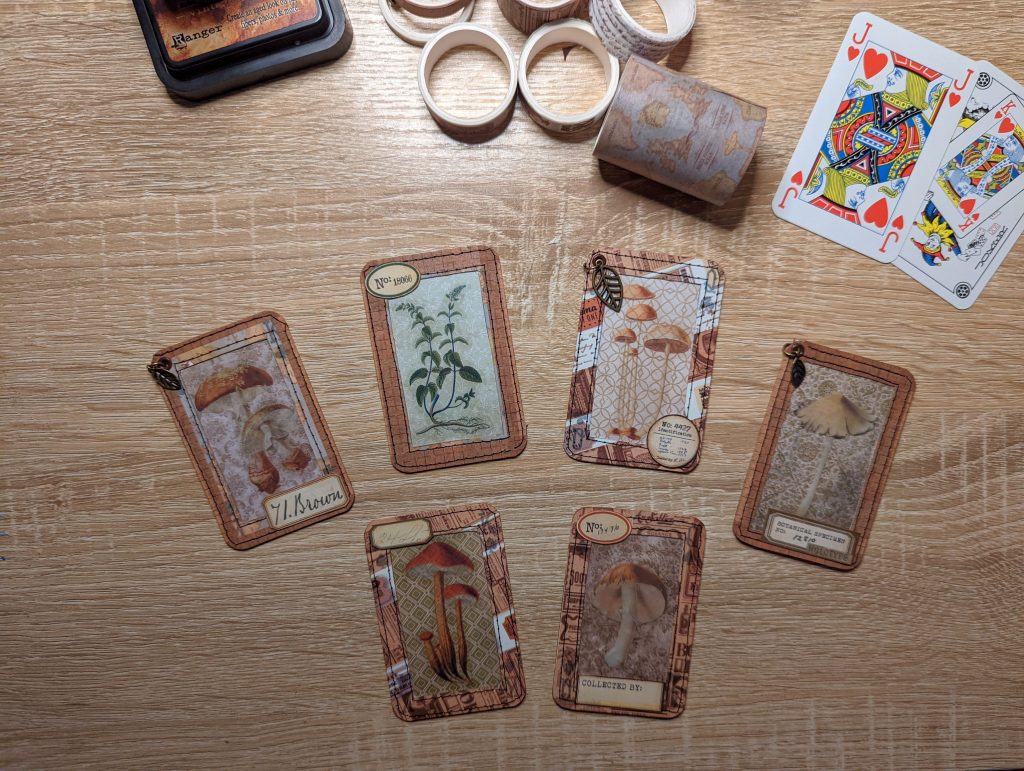
Belly Bands
A belly band or bellyband is a piece of ephemera that’s either glued or stitched onto the paper on two sides – either top and bottom or on the left and right – so something can be tucked behind it.
You can make belly bands out of almost anything, just as long as it’s sturdy enough. Thick scrapbook paper, cardstock, fabric trims and envelopes all make great belly bands. And as with everything else, you can decorate them however you like.
Here’s an example of a belly band I made out of a beautiful vintage fabric trim for my botanical boho journal:

And here are a couple I made out of junk mail envelopes that also double up as pockets for a journal card or thin notebook:
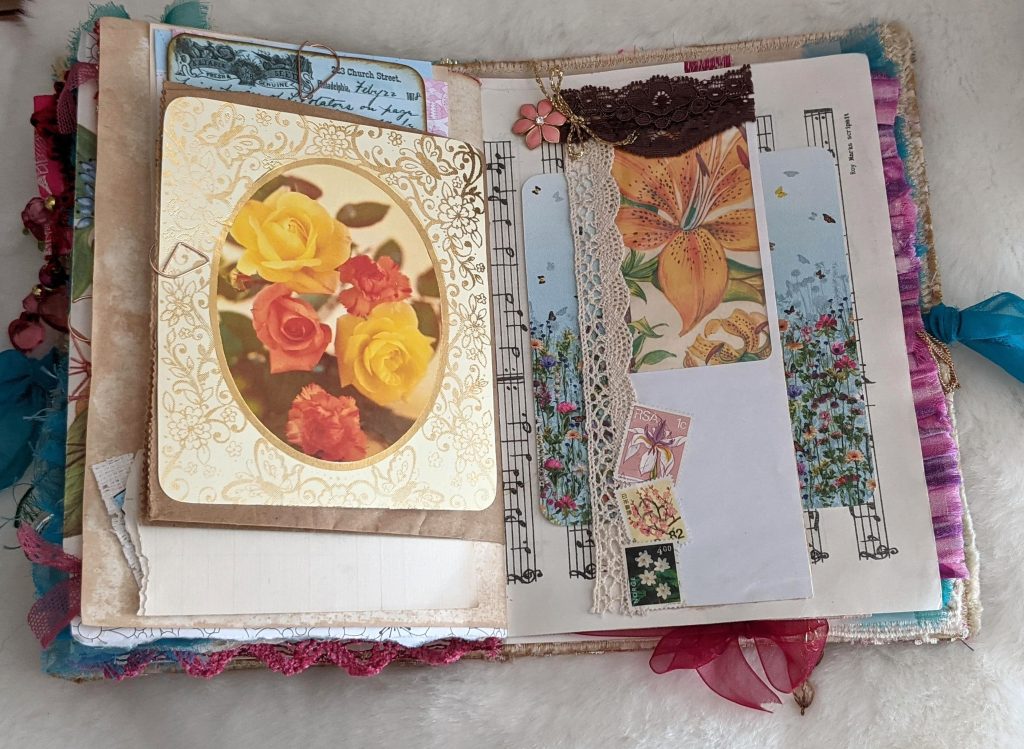

Bling, Charms, Dangles
Bling, charms and dangles are all types of embellishments you can add to a journal. Whether you decide to upcycle some old jewellery, a vintage brooch or even a keyring, you can never have too much bling!
You can add charms or dangles to the tops of tags, use them to embellish your front covers, hang them from tabs and ruffles on the side of a page, or even along the spine of your journal. Use paperclips, hinge clips, safety pins or bulb pins to attach them – easy peasy!
Boho
In the junk journal world, boho is a type of theme or aesthetic. It’s a little hard to define as it can be interpreted in different ways.
Some see it as anything that involves traveller or gypsy images. Others think Indian sari fabrics and trims work well for boho. While others think boho is all about colour and lots of it.
I believe all of those people are right as boho can be a smorgasbord of different things. Generally speaking, use rich jewel colours like reds, oranges, golds, purples, blues, greens and pinks and lots of and bling – and you can’t really go wrong!
Here’s my take on the boho theme for my botanical boho junk journal.

Clusters
Clusters are a type of junk journal embellishment you can use to decorate your pages, envelopes, front covers and more. They involve layering different materials together – usually fabric and/or paper scraps – which you can then secure with a button or brad. They’re a great little scrap buster!
Check out this list of my favourite junk journal embellishments for some ideas >>

Challenges
YouTube, Facebook and Instagram are full of junk journal challenges if you know where to look – and they can be a great source of inspiration to get you out of a creative rut.
Join a junk journal Facebook group (like this one!), for instance, and you might be tasked with creating anything from tags and clusters to full-blown junk journals, often following some guidelines or a particular theme.
Or you might see YouTubers and Instagrammers running challenges for you to join in with like mass making challenges or using up your junk mail. You can then share your makes in a Facebook group or by using a special hashtag.
When I first heard about junk journals, I took part in a “Scrap Pack Challenge” in the Junk Journal Trading Post group on Facebook where we had to send a pack of scraps to our partner and receive one from them. We then had to make a mini journal, two tags and two clusters using the scraps.

It was a lot of fun and I created so many things I wouldn’t have ordinarily made because I received things that wouldn’t have usually been in my stash! Since starting my own junk journal Facebook group, we’ve hosted various events and challenges – ranging from scrapbusting challenges to junk journal bingo and more!
Collage
A collage is a technique you can use when decorating your pages or ephemera. It involves layering several different elements together to create your own “picture” or “scene”.For example, you might glue some book text on top of a piece of tissue paper and then add a focal point and label on top of that – just like you’ll often see me do on YouTube.
Collage Fodder
Collage fodder refers to the materials and papers you gather specifically for making your collages. This includes supplies like textured papers, tissue paper, old book pages and dried tea bags to name a few.
It’s usually helpful to keep these supplies together in a bag, pouch or folder so you know exactly where to find them when you next do some collaging.
Collage Masterboard
A collage masterboard involves glueing your scraps of paper onto a larger piece of paper or cardstock to make an interesting background. You can then cut into it to make coordinating ephemera for your journals such as tags, journal cards, pockets and more.
They’re fun to make, super easy and you’ll be surprised with your results each time you make one!
You could even scan your masterboard into your computer so you have one to print out and use at any time. Just be careful of doing this if you’ve used any copyrighted text or images such as book pages or digitals.

Crop-a-Dile Eyelet Setter
A Crop-a-Dile is an eyelet setting tool made by the company We R Memory Keepers and it’s a very popular tool among junk journalers and crafters. Once you figure out which settings you need for your type of eyelets, you’ll find it quick and easy to make journal closures and adorn your tags with eyelets – and quietly. No need to hammer on metal and keep all your neighbours awake!
December Daily or December Daily Journal
A December Daily or December Daily journal is a type of journal you can make, which is usually Christmas or winter-themed. The idea is that you or whoever owns the journal can write in it every day throughout December.
Digitals or Printables
Junk journal digitals or printables are a type of paper you can buy and download online – usually from sites like Etsy, Buy Me A Coffee, Ko-Fi and Patreon. You can then print them yourself at home or take them to a print shop. You can also design your own digitals if you’re good with a computer.
Digitals come in all different colours, themes and designs and are so pretty to work with. They’re also not too expensive if you can print them out at home – especially if you have an EcoTank printer like I do.
You can find a list of my favourite printables here. I also design and sell my own via my Etsy shop.

Edith Holden
Edith Holden is a writer from the early 1900s who penned a very popular book among junk journalers called “The Country Diary of an Edwardian Lady”.
Her illustrations of birds, butterflies, wildflowers and other flora and fauna she encountered during her “nature walks” are so beautiful while her diary entries use perfectly meticulous handwriting.
So, as you can imagine, pages from her book look gorgeous as junk journal pages or ephemera.
Her book can be a little pricey these days given its popularity, but you might be lucky enough to find used copies on eBay, Etsy or in your local Goodwill or in a used bookstore.

Embellishments
Junk journal embellishments are anything you use to decorate your pages, pockets, tuck spots or journal covers, such as clusters, charms, ruffles, snippets, die cuts, fussy cuts, etc.
You might be surprised how pretty a blank page can look once you’ve added a little something to it. Check out these examples for some ideas!

Ephemera
The official definition of ephemera is: “Things that exist or are used or enjoyed for only a short time.” While, in the junk journal world, ephemera is defined as: “Anything you add to your junk journal.”
This might include vintage ephemera, as well as things like tags, journal cards, pockets, tuck spots, belly bands and anything else you make or buy to glue or clip into your junk journal.
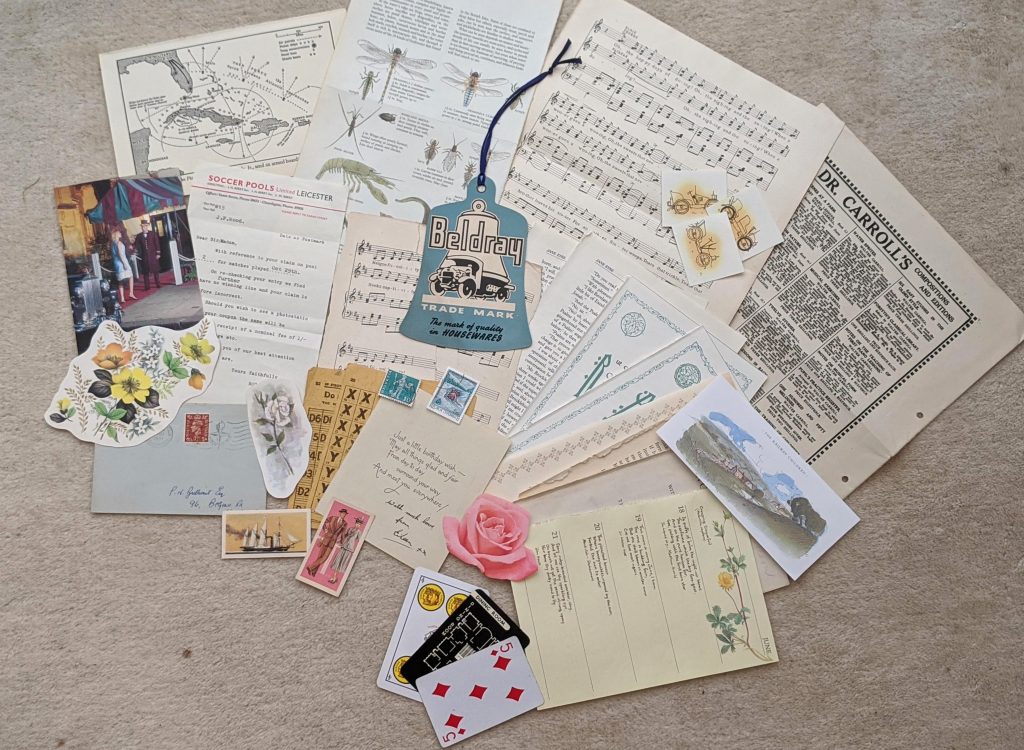
Flip Ups, Flip Downs, Flip Outs, Everything That Flips
If you create a page that folds out or a pocket that flips open, then you’ve created some kind of “flip” for your junk journal.
You can have them flipping upwards, downwards, to the left or the right – and they add such a fun and interactive element to your journals. You can even use them to hide secret journaling spots.

Flip Through
A flip through is usually a video, but could also be a detailed blog post with photos, showing your journal in detail.
As most pages are different in junk journals and you would’ve added lots of beautiful ephemera to them, a flip through helps fellow junk journalers and potential customers see every inch of your journal.
Flip through videos also enable you to explain why you’ve chosen certain colours or embellishments. For inspiration, check out my junk journal flip through playlist on YouTube to see some of my videos and finished journals.
Floating Pockets
Floating pockets are like normal pockets in a junk journal, but the “floating” aspect refers to them being “moveable”. If you clip a pocket onto your page instead of glueing it down, for example, then you’ve made a floating pocket. The great thing about floating pockets is that you can have pockets on both sides if you want to!
Fussy Cuts or Fussy Cutting
If you’ve ever cut out an image from a book page or cut around part of a greeting card, then you’ve probably done some “fussy cutting”. A “fussy cut” is just the fruits of your labour – so the pretty flower you cut out for example.
But for it to be considered a fussy cut, you must cut directly around the item without leaving a border. Otherwise, you’ve done kiss cutting instead.
Gelli Plate / Gel Plate / Gel Press
Gelli Plates are reusable printing plates that feel and look like gelatin, but they’re not actually made from animal-based gelatin. You can use them to make fun prints as artwork and to use as journal pages.
You start by rubbing paint onto your Gelli Plate with a brayer tool. You can then lay interesting materials on top of the paint to get fun patterns. Popular items to use include bubble wrap, leaves, fabrics and other textured materials.
Because of what the Gelli Plate is made from, it “stores” the memory of both the paints and textured materials, so when you lay your paper over the top, you’ll pick up both the colours and patterns. Neat, huh?
Here’s a fun video from Alison at Craftyalicreates where you can see how she uses her gel plate and what effects and colours she managed to get from it.
Gesso
Gesso is a useful mixed media art supply to help you prepare your base before using paints, distress inks and any other mediums you want to use in your artwork and journaling.
For instance, you might use gesso on corrugated cardboard to give your distress inks a “base” they can cling onto. Without gesso, the cardboard is likely to sop up your inks and leave little to no colour on the top layer. With gesso, the inks sit on top of the gesso instead.
You can also use white gesso on top of book pages to enable you to write over the top of them. The gesso will likely give your pages a rough texture, but this is a good base for writing on.
You’ll usually find gesso in either white or clear forms.
Glue Books or Smash Books
A glue book is a journal or notebook that you glue things into. Most journalers use blank notebooks and they make pretty collages and art spreads on the pages.
You might glue fussy cuts onto your pages, as well as words and sentiments, tickets and other ephemera.
Sometimes, glue books are also called “Smash Books”. From what I understand, they’re essentially the same thing.
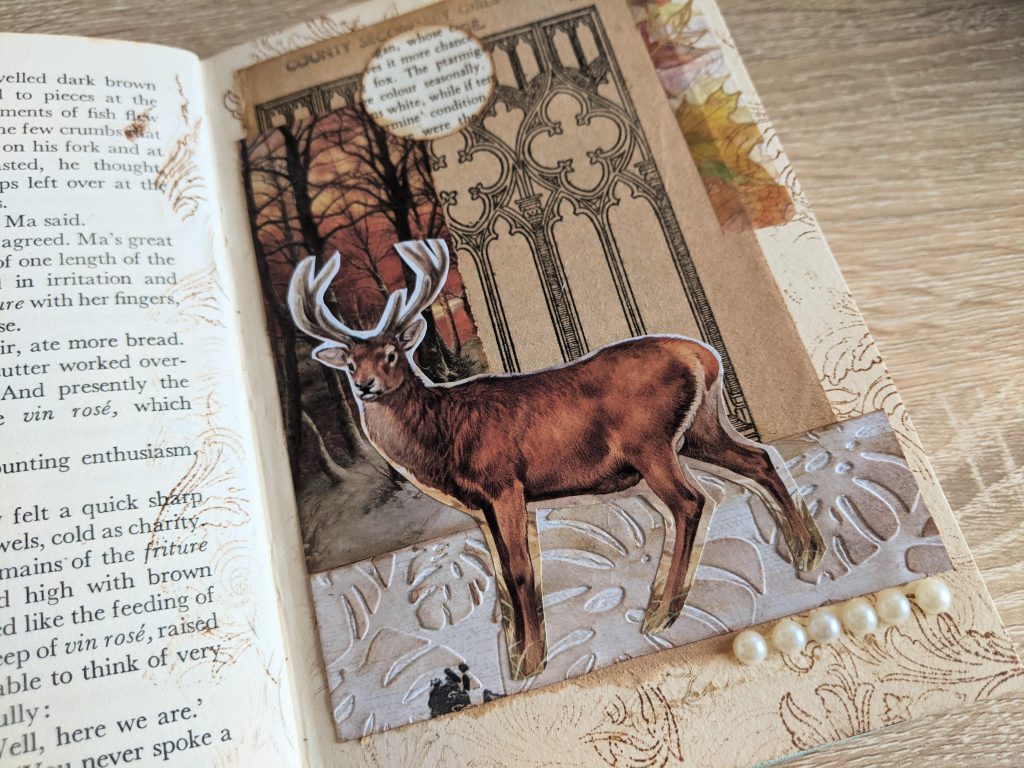
Inchies
An inchie is a 1×1-inch square embellishment, which you can decorate however you like. Think of it like a mini (very mini) art canvas.
You might want to use your inchies to decorate your journal pages, pockets and other ephemera. Or even use them as a base with which to make altered paperclips and other fun embellishments.
Journal Cards
Journal cards are cards that you create, which can be written on. You can make them out of absolutely anything – from greeting cards and ephemera to playing cards and junk mail – and everything in between.


Journaling Spots
Journaling spots are another place for you to write on, in, or under. There might be a bit of blank space on a colourful page. That’s a journaling spot. You might even “hide” a journaling spot underneath something that flips out, up or down like these little spaces I created that also double up as pockets for little tags or ephemera:

Junk
“Junk” is open to interpretation, but I see it as anything that people usually throw away.
That unwelcome piece of advertising that comes through the door? Junk. The envelopes your bills come in? Junk. That old newspaper you’ve finished reading? Yep, that’s junk too.
We junk journalers never like to throw anything away, so I challenge you to grab some “junk” and see what you can make with it – because there’ll always be something beautiful or functional you can create with it.
Check out my “Shop Your Trash” playlist on YouTube for lots of ideas >>
Junk Journal
A junk journal is a diary, journal, planner, etc that’s made (usually by hand) out of found and recycled materials, such as trash, packaging, paper scraps, book pages, music sheets, maps, illustrations and ephemera (think stamps, ticket stubs, postcards, greeting cards, fussy cut pictures, etc), and is a place where you can record your thoughts, ideas, memories, and musings.
Kiss Cutting
Kiss cutting is like fussy cutting in that you’re cutting out an image from a book, greeting card, scrapbook paper, etc. But with kiss cutting, you leave a border around the outside of the image – just like a sticker that has a white border around it.
Lapbooks or Lapbook Journals
Here’s where things might get a little confusing (assuming you’re not already confused, of course!) Because lapbooks and lapbook journals are too very different things.
If you do an online search for “What is a lapbook?”, you’ll likely see educational resources used in schools where children have books that fold out and fit in their laps to help them learn about a particular subject.
But within the junk journal world, lapbooks are journals that fold out multiple times and that contain lots of flips and flaps inside for pockets and writing spots.
Usually, they’re made from two book covers of the same size, so when they fold back up together, everything looks neat and tidy.
If you’re wondering what the difference is between folio journals and lapbook journals, then it’s essentially the different shapes. Lapbook journals fold in to meet each other while folios can just open like a normal book before revealing the flip outs and such.
Check out this playlist to see how I made my Secret Garden lapbook >>

Matte Gel Medium & ModPodge
Both Matte Gel Medium and ModPodge are types of glues that you can brush onto your work.
Within junk journaling, they’re often used in decoupage. While you may find similar results when using them, the effect you get afterwards is likely to be quite different.
ModPodge takes a long time to “cure”, so you may find it’s still tacky days or even weeks after using it. Matte Gel Medium has a much shorter drying and curing time, so you’ll likely only have to wait minutes or hours for it to dry and there should be no tackiness. Matte Gel Medium is my preferred choice when decoupaging.
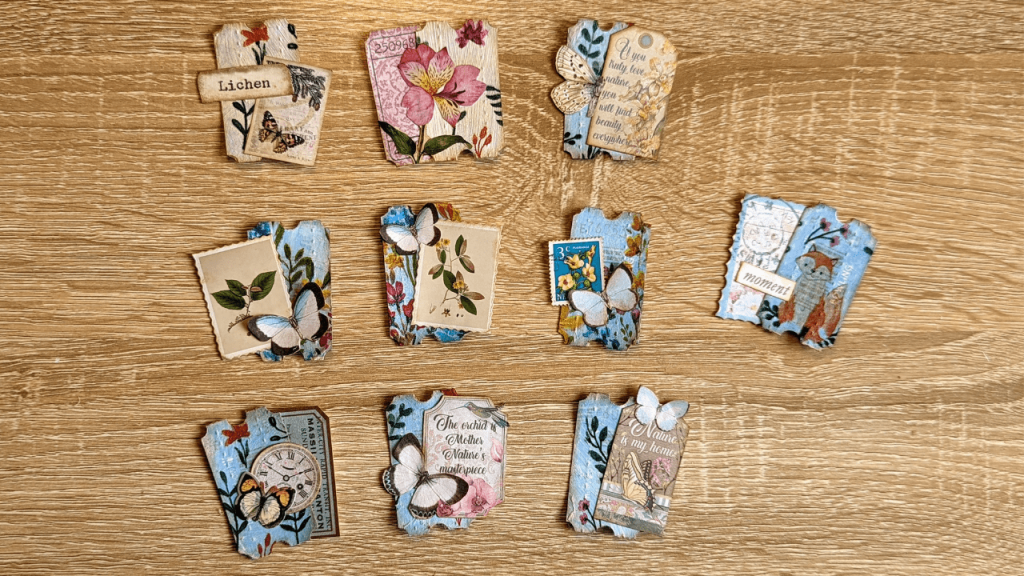
Mixed Media
Mixed media is a technique, which involves layering and using a variety of different supplies or “mediums” – usually to decorate something.
For example, you might use paint, texture paste, napkins and distress inks on a project. This is a form of mixed media.
It’s worth noting that this technique isn’t only used in junk journals or journal making; it’s also a popular technique in art journals, modern art pieces and the like.
Pockets
A pocket in a junk journal is a little place for you to pop something inside. Unlike a tuck spot, a pocket is usually glued or stitched on three sides to give you just one opening.
You might glue a paper pocket down onto a page for some ephemera to sit inside.
You might clip a vellum pocket onto the side of a page for a movable or “floating” pocket for tags and other goodies.
You might stitch an envelope or paper bag into your journal signature and have that as a pocket page.
You might even pop a pocket onto the top of another pocket (a double pocket if you will), or even add a pocket to the front or back of a tag.
You can make pockets out of all sorts of things like vellum, book pages, pretty paper or card, envelopes and more.
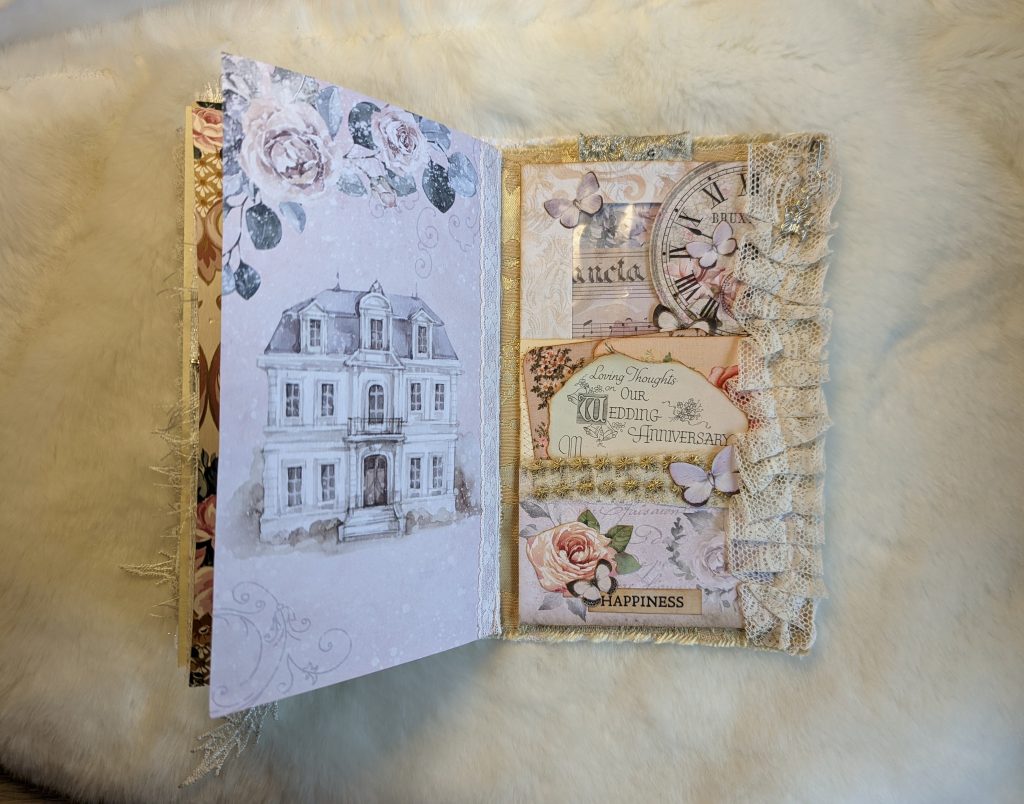
RAK(s) or Happy Mail
RAK stands for “Random Act of Kindness”. The junk journal community is one of the most generous and giving communities I’ve found online, so if you join an active Facebook group, you’ll often find something on there called a “RAK list” or something similar.
The idea is that you choose someone or several people to send random goodies to in the post. Or you might even be lucky enough to be on the receiving end of getting a surprise RAK in the post.
A RAK could be some junk journal supplies, something handmade or a mixture of the two.
I’ve been fortunate enough to receive a couple of RAKs recently and mine were stuffed full of various items like book pages, illustrations, tea-dyed paper, ruffles, fabrics, trims; absolute all sorts that I could use for my journals.

When you receive a RAK, obviously be sure to thank the person who sent it to you. But it’s also a nice idea for you to pay it forward and send a RAK on to someone else as well. That way it’s almost like a circular thing where lots of people receive RAKs in the post. And they can really make someone’s day!
You might also hear RAKs referred to as “happy mail”. The idea is exactly the same – you’re sending something to someone to make them smile and feel loved. Don’t know anyone within the junk journal community to receive a RAK from? I send “Mahalo Mails” to my top-tier Clubhouse Members every month – and they love them!
Rolodex Book
A Rolodex Book is based on the old Rolodexes that were once a common sight on desktops everywhere. While the original Rolodex was used to store business cards, addresses or other small notes and pieces of paper, junk journalers now make them by upcycling hardback books and using them to store ephemera.
The idea is that you fold the book pages inside a book in such a way as to create pockets, which you then “anchor” to the book cover so that it can stand on your desk. Here’s an example from Tiffany at Bluebird Lane Creations (isn’t it gorgeous?!)
Ruffles
A ruffle can be made out of fabric or paper and they’re usually sewn – either by hand or with a sewing machine – to get a “ruffle” effect.
You can use ruffles to embellish the side of a page (they make the side view of your journal look extra gorgeous!), you could use them as tag or journal card toppers, as page tabs or even as embellishments on the front of your journal.

Shabby Chic
Shabby Chic is a type of aesthetic to describe what your journal looks like or what style it is. However, “Shabby Chic” is actually trademarked, so be cautious of trying to sell or pass off your own creations as Shabby Chic. With this aesthetic, you’ll often see a lot of lace, fabric, feminine colours and pastels.
Here’s my take on an ephemera folio that could be classed as “Shabby Chic” – but I chose to call it “Pink Chic” or “Pretty Chic” instead to get around the trademark.

Signatures
A signature is a collection or group of papers that you bind together to make a journal. You might have heard people refer to their journals as having one signature, two signatures, or three or more signatures.
Each signature is its own collection of papers that then get bound together into your cover. You may like to use completely different papers in each signature or similar papers. As with everything junk journal-related, it’s completely up to you.
Depending on how thick your papers are and how much ephemera you plan to add to your journal, you’ll probably want to aim for around 8-12 papers per signature.
Snippets or Snippet Rolls
Snippets are a type of junk journal embellishment. They’re similar to clusters in that they’re made up of layers of fabric, paper or a combination of the two. The main difference is that a “snippet” refers to the process of snipping or cutting a strip or roll down to make your embellishments.
Here’s an example of my snippet roll and how I turned it into individual snippet embellishments >>


Steampunk
Steampunk is another type of aesthetic. This time, it’s very “industrial” in its appearance. Think steam trains, clocks, cogs, chains, metallic colours and machinery/inventions.
Some journalers also pretty it up a bit by mixing in lace, flowers or feminine colours with all of the industrial goodness. This is sometimes called “Romantic Steampunk” or “Shabby Steampunk”.
Sticker Book
A sticker book appears to be a relatively new term within junk journaling. The idea is that you can create collages and other fun journal spreads using stickers. Think of this like working in an art journal but without the need to draw, paint or fussy cut. Just work your magic with stickers instead!
Tabs
Tabs are usually on the side of a page and serve two purposes: to help you find a particular page or section of your journal quickly and easily and to give you something pretty to look at – especially when looking at your journal from the side.
You can glue or stitch them onto the page and you can make them from fabric, cardstock or thick paper, maybe even some lace – anything that’s strong enough to be pulled around a bit without tearing or ruining your page.
You could also add tabs to a journal card or tag to make it easier to pull them out of a pocket. Or you could add them to a flip up, flip out, flip down, etc to make it clear that there’s something to lift or pull.

Tags
Tags are like journal cards. The idea is for you to write on the back or front of them, but tags are shaped like luggage tags, with the corners cut off.
Junk journalers usually add tabs, ribbon or lace to the tops of the tags whereas journal cards don’t usually have this on them – unless it’s for decorative purposes.
You can make tags out of almost anything, such as packaging, cardstock, book pages, masterboards and more.

TN or “Traveller’s Notebook”
TN stands for “Traveller’s Notebook” and refers to the specific size of a journal. A standard size TN is approximately 4.5 inches x 8.25 inches, so it’s slimmer than a standard A5-sized journal (usually 9×6 inches). As the name suggests, a TN is an ideal size for slipping into your handbag for some on-the-go journaling.
Tucks or Tuck Spots
Tucks or tuck spots are like pockets, but they’re usually open on two sides rather than just one. Tuck spots are useful when you want to add some larger or thicker ephemera to your journal, which won’t fit into pockets. Here are a few examples from one of my journals:



Twinchie
Similiar to inchies mentioned earlier, a twinchie is a 2×2-inch square embellishment. You can decorate them however you like – think of them like a mini art canvas.
You can then use them to decorate your journal pages, pockets and other ephemera. You may even want to turn them into altered paperclips, mini tuck spots or even fun interactive sliders like I did in this video.
Vintage
Vintage is another type of aesthetic, but it can also refer to anything that’s over 20 years old. From an aesthetic point of view, expect to see lots of tea- or coffee-dyed papers, vintage trims, neutral colours, Victorian or Edwardian illustrations and black and white or sepia-toned photographs.

Writing Boards
Because of all the ephemera and embellishments you can add to junk journals, the pages end up having uneven surfaces and lots of lumps and bumps. Writing boards can be slipped underneath the page you’re writing on to give you a flat surface, making it easier for you to journal away!
You can easily make one from some heavy-duty cardstock or even a book board that has come away from the spine. Decorate it up with illustrations or book pages, finish with some Matte Medium glue and pretty book corners – and you would’ve made something pretty but also very useful!
Here’s one I made for my botanical boho junk journal. I made mine from a vintage book board – just like I’ve shown in this video.
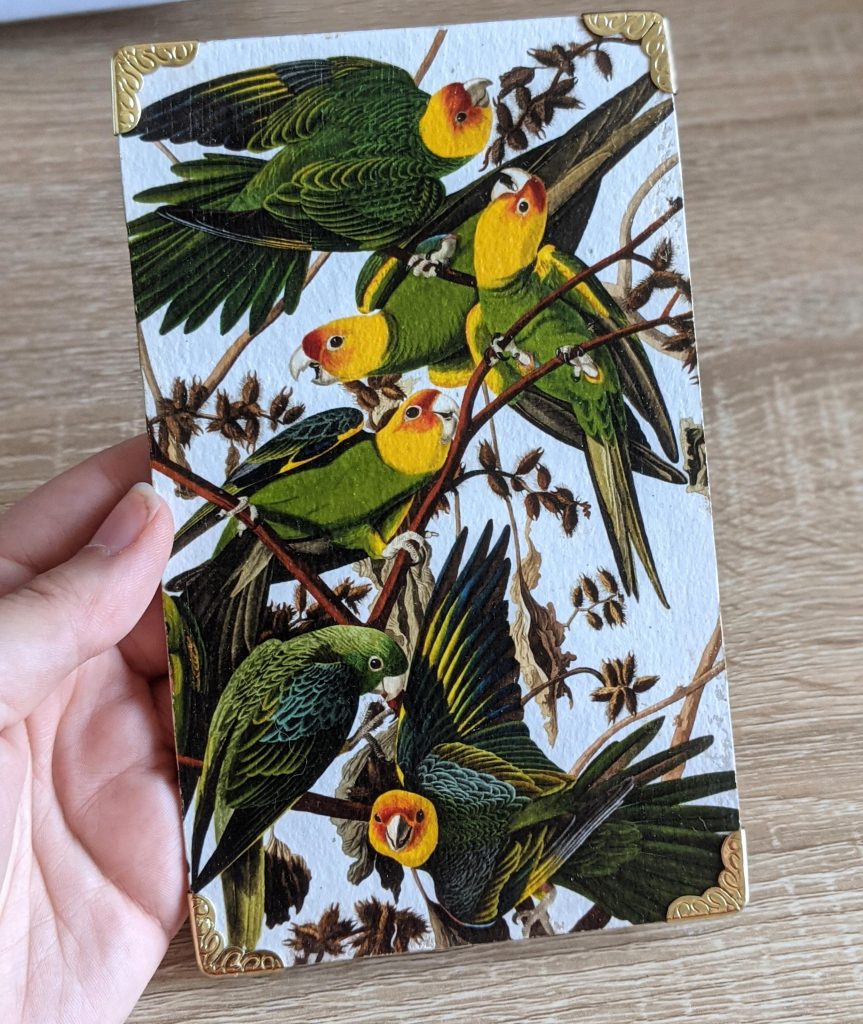

Read More About Junk Journals
I hope my junk journal definitions and glossary have helped you debunk some of those mystifying acronyms and jargon. Here are some more articles to expand on what you’ve learned today:
- What Is A Junk Journal?
- How To Start Junk Journaling: My Top Tips & Ideas For Beginners
- How To Make A Junk Journal From Scratch (Step-By-Step)
- FAQs About Junk Journaling: 20+ Tips You Need To Know
- The Intriguing History Of Junk Journals
- 35+ Types Of Junk Journals You Can Try Making
- What is Junk Journal Ephemera?
- Everything You Need To Know About Junk Journal Signatures
- What Is A Collage Masterboard & What Do You Do With It?
- Are Junk Journals Still Popular? 10 Reasons Why I Love Them
PS: If you spot something I’ve missed off my glossary, please leave me a comment below so I can add it asap! And don’t forget to grab the printable version of my glossary for easy reference.

Junk Journal Toolkit
📦 What do I need to get started?
If you’ve got paper, glue, scissors and something to bind your pages with (like a needle, thread and an awl or pokey tool), you’re good to go! Check out my essentials vs. nice-to-have supply list for more info.
🤯 I’m overwhelmed by tutorials and ideas. Where should I start?
Start with my free Mini Junk Journal Masterclass. It walks you through the process step-by-step. Even though it focuses on a mini journal, the same tips apply to any size journal.
❓ I don’t understand the terminology. Can you help?
Absolutely! My A–Z Junk Journal Glossary breaks down all those confusing terms and acronyms. Jargon be gone!
🪡 How do you keep your binding neat?
I use my bookbinding cradle to line up my holes and avoid punching too far through the pages. Smaller holes give a neater and more secure binding, and I use this thin upholstery thread for a cleaner finish.
🧵 Do I need a sewing machine?
Not necessarily! A basic sewing machine is helpful for making fabric-covered journals, but strong fabric glue can work just as well. If you stick to paper-based journals or folios, you don’t need one at all. I like the sewn look and making fabric-based journals, so I personally use a simple machine (similar to this) that’s lasted me over 10 years – it’s a trusty part of my toolkit.
🖼️ What digital papers do you use?
I use a mix of my own designs and other favourites. You can see examples here. New to digitals? Check out my mega bundle for a big saving on some of my designs or sign up for my Mahalo Clubhouse membership to get brand new digitals sent to you every month.
📜 What’s the best paper for printing digitals?
I use this 100 GSM Presentation Paper for vibrant and high-quality prints.
🖨️ What printer do you recommend?
I love my Epson Ecotank. It’s affordable, reliable and the ink lasts ages. I used to spend £30 a month on ink – now I refill just once or twice a year for under £30. While I haven’t used it myself, some other crafters recommend the HP Instant Ink program.
🖇️ What glues do you use?
My go-tos are Collall All Purpose, Cosmic Shimmer and Beacon 3-in-1. Here’s how I use each one.
📖 What books are best for junk journaling?
I love using second-hand nature and botanical books. Here are some great titles to look for next time you’re thrifting.

Your blog had fabulous information. Thank you SO much for publishing this.
Thanks so much for commenting, Connie! I’m glad you found this helpful 😀 xoxo
Such good info. Thanks. Several techniques were totally new to me. Yay.
Wonderful! I’m glad you found it helpful Janet ❤️ xoxo
This blog is so helpful to me as a beginner thank you.
Thanks so much for commenting! I’m really pleased to hear you found this helpful 🙂
Happy Crafting! xoxo
I was quizzing myself to see how much I have learned over the last 9 months. You got me with “kiss cutting” 😄 Thank you for sharing this.
Hehe, well I’d say that’s very good going Phyllis! The funny thing is that it’s 6 months or so since I wrote this and I probably have even more to add.
We’re always learning huh? 😀 xoxo
This was awesome and very helpful, thank you!
Thanks so much for commenting Casey! I’m glad you found it helpful. Happy Crafting! xoxo
Thank you, thank you, thank you! This information has been so very helpful! How do I join a Facebook group of junk journalers? I am very new to this and would love interacting with others loving this creativeness so any help would be greatly appreciated.
Hi Linda,
You’re most welcome! I’m so pleased you found my blog post helpful 🙂
There are quite a few junk journal groups on Facebook. You can just search for them in Facebook itself. And you can always join the one that I co-own with a friend: https://www.facebook.com/groups/junkjournalideasandinspiration/. We’d love to have you join us in there xoxo
Thank you very much for all your explanation! blessings ✨️
You’re most welcome Natalia! xoxo
Hi Justine, I am new to journaling and have sort of pressed my way and watched many, many YouTube videos to understand what junk/art journaling is all about.
While I have done a lot of guesswork, your information has confirmed some things for me and informed my knowledge base. This information is excellent and so helpful. Thank you very much for sharing. I now understand how to use all this “stuff” I have purchased and found in my home for journaling! LOL Thanks again.
Hi Cherlyn,
Thank you so much for your comment. I’m really pleased you found the blog helpful 🙂
Have fun using all those goodies you’ve bought and found… this craft is just so addictive! Hehe xoxo
Thanks. Your Glossary was quite educational. I love to create master boards. So relaxing. Have a Merry Christmas!
I’m glad you found it helpful Sharon 😀 Have a lovely Christmas! xoxo
Thank you so much for the Glossary of Junk Journal jargon. Your time in research, writing and publishing this article is a definitely a RAK that will give pleasure and understanding to all who read it.
Have fun playing with ‘Junk’.
Thank so much for your kind words – I’m so pleased you found this glossary helpful 🙂
Happy crafting! xoxo
I am thrilled that I stumbled upon your site Justine! I recently became interested in Junk Journaling and sometimes feel like I go down a rabbit hole trying to research and understand the elements to this craft. Your article was so informative and has really helped me in understanding some of the different terms that I had been hearing and reading about. Now I don’t feel as intimidated and am ready to dive in and get started creating! Thank you for sharing your knowledge with those of us who are excited to learn!
Aww yay, I’m so pleased you found this helpful Martha!
I agree – all the terms and stuff can be so confusing when you start. But it all makes sense in the end once you know what everyone’s talking about.
I’m happy to hear you’re ready to get stuck in – just be prepared to get very addicted to this fab craft lol. Have fun! xoxo
would love to have a print friendly version of this a-z article!
Hi Laura,
Noted! I’ll see what I can come up with; I’ll try to get this done within the next month or so. I’ll give you a nudge here when I’ve got something to share. I’ll likely also send it to my email subscribers: https://houseofmahalo.com/subscribe/ xoxo
Thank you for your insight into acronyms. I have just started journaling as a retirement hobby. Unfortunately I suffer from short term memory loss and although I manage very well …new things take a long time to come easy.
I am shabby chic all the way. Peonies,cats, lace, buttons…I love them all. I have ordered from Etsey but am so bad with technology(STML) I have people do it for me but I want to print on different gsm, so I need to do it myself.
I watch UTUBE everyday. The people are so great. Some are so talented and can speak like you are right there. I love it.
Enough rambling, thanks for being you, I’m gonna go have fun.
Aww, lovely comment, thank you Lori! I’m glad to hear you’re getting stuck into this fun craft – enjoy every minute 🙂 xoxo
Thank you so much! Yes, I jumped in the deep end of the junk journaling world on YouTube, after getting started with an altered book. So many terms are thrown around as if we should all know them, and I hadn’t found such a definitive list until yours. Really helpful, and I’ve followed several of your links to watch the videos or join the Facebook groups.
Hi Mari,
I’m so pleased you found the blog post helpful! 😀
And thank you so much for the follows! I have plenty more to share about JJ’s seeing as I’m so addicted to them lol.
Talk to you soon and happy crafting! xoxo